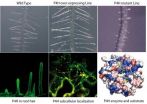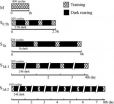(Press-News.org) Co-author Professor Tony Bacic from the ARC Centre of Excellence in Plant Cell Walls, School of Botany and the Bio21 Institute, at the University of Melbourne, said plant cell walls (plant biomass) represent the world's largest renewable resource.
"Plant sciences have become a major new driver of international research due to their central role as renewable sources of transport fuels, as functional foods to improve human health, and as a source of raw materials for industrial processes," he said.
The study has been published in the current issue of the international journal Science.
Most plant roots are covered in fine root hairs which seek out nutrients in the soil and increase the roots' surface area, allowing more water and nutrients to be absorbed.
"The root hair is therefore very important and this work could have applications for plants growing in dry and nutrient-deficient soils as they need to optimise their nutrient and water uptake," Professor Bacic said.
The root hair is a single tubular cell which grows out from the plant's root surface and is surrounded by a wall rich in complex carbohydrates and glycoproteins. This wall surrounds the cell to strengthen it, like a building scaffold.
So to study root hair growth, an international multidisciplinary team of researchers from Argentina, Australia, the United States, Denmark and Brazil targeted genes involved in the production of wall glycoproteins in the model laboratory plant Arabidopsis.
The team identified three groups of genes required for the assembly of the cell wall scaffold glycoprotein, called extensin. When the genes were prevented from functioning, the root hairs were stunted. Without these scaffold glycoproteins and their complete sugar decorations they don't form their correct molecular shape to enable root hair growth. What controls the expression of these genes is the next important question to be addressed.
"This study enhances our fundamental understanding of the growth of plants, our major renewable resource, and would not have been possible without our international collaboration through the ARC Centre of Excellence in Plant Cell Walls," said Professor Bacic.
INFORMATION:
Not just another brick in the (plant cell) wall
2011-06-19
ELSE PRESS RELEASES FROM THIS DATE:
First X-ray lasing of SACLA
2011-06-19
RIKEN and the Japan Synchrotron Radiation Research Institute (JASRI) have successfully produced a first beam of X-ray laser light with a wavelength of 1.2 Angstroms. This light was created using SACLA, a cutting-edge X-ray Free Electron Laser (XFEL) facility unveiled by RIKEN in February 2011 in Harima, Japan. SACLA (SPring-8 Angstrom Compact free electron LAser) opens a window into the structure of atoms and molecules at a level of detail never seen before.
The use of ultra high-intensity X-ray free electron laser light to explore the miniature structure of matter, until ...
The way you relate to your partner can affect your long-term mental and physical health, study shows
2011-06-19
The potentially lasting implications of day-to-day couple conflict on physical and mental well-being are revealed in a study published today in the journal Personal Relationships.
Until now research has concentrated on the immediate effects of romantic conflict, typically in controlled laboratory settings. In one of the first studies to look at the longer term, Professor Angela Hicks investigated the physiological and emotional changes taking place in couples the day after conflict occurred, specifically taking into account the differing styles of emotional attachment ...
World Health Organization releases latest Dengue Bulletin
2011-06-19
Luiz Tadeu Moraes Figuedo's paper on dengue in Brazil confirms the country's worsening trend; from 1999-2009, where cases rose at 6.2% per year and dengue deaths at 12.0% per year.
Carmen Perez and co-workers, reporting on dengue vector control in Puerto Rico, found that 83% of the costs ($1.97 per person per year) were funded by the lowest and often the least financed level of government: municipalities.
Examining dengue cases imported into France, Guy LaRuche documented the alarming increase in cases originating from Cote d'Ivoire from only one case in 2006-07 to ...
No healing in a vacuum
2011-06-19
Negative-pressure wound therapy probably does not promote healing. This is the conclusion of Frank Peinemann and Stefan Sauerland's meta-analysis in the current edition of Deutsches Ärzteblatt International (Dtsch Arztebl Int 2011; 108[22]: 381-9).
In negative-pressure wound therapy (NPWT), wounds are covered with an airtight film and an adjustable negative pressure is applied using an electronically controlled pump. The negative pressure drains wound exudate and is thought to promote healing. This procedure is used in particular for chronic persistent wounds and complicated ...
'Lost' bats found breeding on Scilly
2011-06-19
A University of Exeter biologist has discovered a 'lost' species of bat breeding on the Isles of Scilly (UK). A pregnant female brown long-eared bat is the first of its species to be found on the islands for at least 40 years. It was discovered by Dr Fiona Mathews, Senior Lecturer at the University of Exeter, a postgraduate student and a team from the Wiltshire Bat Group.
The Scilly Isles Bat Group called in Dr Mathews and her team to help them find out more about bats on the islands. The researchers set up a radiotracking study, with funding from the Isles of Scilly ...
Discovery of a new mechanism of gene control that is associated with cancer
2011-06-19
Researchers headed by Joan Massagué at Memorial Sloan-Kettering Cancer Center (MSKCC) in New York and by María Macías at the Institute for Research in Biomedicine (IRB Barcelona) have identified a complex mechanism by which some proteins that are essential for life, called Smads, regulate the activity of genes associated with cancer. The fruit of three years of intense work, the study reports on the life cycle of this protein, a process that ensures that the protein is destroyed when it has completed its function. These results have been published today in the top journal ...
A better way to remember
2011-06-19
Scientists and educators alike have long known that cramming is not an effective way to remember things. With their latest findings, researchers at the RIKEN Brain Science Institute in Japan, studying eye movement response in trained mice, have elucidated the neurological mechanism explaining why this is so. Published in the Journal of Neuroscience, their results suggest that protein synthesis in the cerebellum plays a key role in memory consolidation, shedding light on the fundamental neurological processes governing how we remember.
The "spacing effect", first discovered ...
Tapeworm drug inhibits colon cancer metastasis
2011-06-19
A compound that for about 60 years has been used as a drug against tapeworm infection is also apparently effective against colon cancer metastasis, as studies using mice have now shown. The compound silences a gene that triggers the formation of metastases in colon cancer. Professor Ulrike Stein (Experimental and Clinical Research Center, a joint cooperation between the Charité Medical Faculty and the Max Delbrück Center for Molecular Medicine, (MDC)) and her research group made this discovery in collaboration with Professor Robert H. Shoemaker of the National Cancer Institute ...
Phobos slips past Jupiter
2011-06-19
VIDEO:
A movie of the encounter made by combining 100 images of the June 1, 2011 Phobos–Jupiter conjunction. The High Resolution Stereo Camera on Mars Express took this sequence.
Click here for more information.
Earlier this month, ESA's Mars Express performed a special manoeuvre to observe an unusual alignment of Jupiter and the martian moon Phobos. The impressive images have now been processed into a movie of this rare event.
At the moment when Mars Express, Phobos, and ...
Low fertility in Europe -- is there still reason to worry?
2011-06-19
The post-war trend of falling birth rates has been reversed across Europe, according to a new study. However, despite an increasing emphasis on family and fertility policies in Europe, this recent development involves social, cultural and economic factors more than individual policy interventions.
For some decades, couples have been having children later in life. But birth-rates among younger women have stabilised and the long-term trend towards lower fertility rates has been reversed.
Politicians are still left to grapple with problems associated with an ageing population ...


